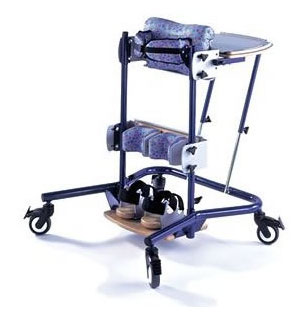Lecky Freestander
DWC ADVANTAGES
Adjustments
Easy to assess child in frame and to adjust
Sales support
Rep is good at responding
Transfers
Can get wheelchairs in close to frame for transfers
Stability
Very steady even when other children stand on the base
Sturdy but light
Manoeuvrability
Easy to move
Comfort
Very comfortable
Appearance
Looks nice and friendly
Tray
Wooden tray
Care
Easy to clean
DWC DISADVANTAGES
Transfers
Pelvic support needs to go onto child before they are stood. This is difficult if no independent weightbearing is possible. (This applies to all Lecky frames).
Ease of use
Velcro waist straps can be confusing initially. Easy to put on the wrong way around.
Foot support
Sandals can only move laterally, they do not move forwards and backwards. (? See manufacturers guidance)
Footplates are a ‘pain’.
Tray
When you remove tray you are left with sharp-edged poles which are dangerous for the child using the frame or other children with access to the frame.
CHILDREN OR CONDITIONS RECOMMENDED FOR (DWC)
- Varies e.g CP children who need some trunk support but have good head control
- Usually children with some weight-bearing ability
- Children with full ROM at hip and knee
- A child that will benefit from the frame physically and psychosocially
- Children that you want to work on actively in the standing frame e.g. trunk control exercises, for better kids and hamstring stretches.
CHILDREN OR CONDITIONS NOT RECOMMENDED FOR (DWC)
- Poor head control
- Flexion contractures
- Asymmetry in weight bearing
- A child that over uses an extensor pattern
- When limited space in the classroom/home (with larger sizes)
- A high functioning child that only needs support from the waist down

